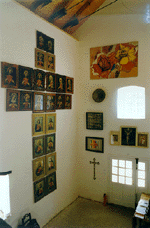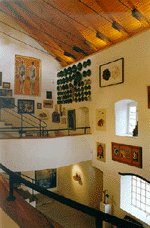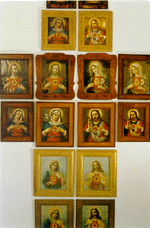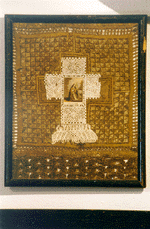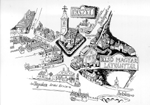
99 KByte
The world treats us lavishly, and we are foolishly wasting its treasures away. At the dawn of the 21st century, spell-bound by comfort and artificial impulses, following the mercantile order of "Use it and throw it away!", we do not even notice that we have been making our environment increasingly uninhabitable. Rubbish - also in a broader context - is slowly becoming one of the major characteristics of our civilisation. And yet there is a different way. But to follow that, we must learn to see again.
In this age of heedless speed, to preserve our childhood creativity and save - what is more, animate - objects proclaimed to be useless is the privilege of but a few. During our visits to destinations across the world, it is with admiration mixed with jealousy that we see efforts made at establishing museums and enriching art collections, as well as the visible results and the good this does to the public. At our quarters, it is a rare phenomenon to find someone building a house, a home, a museum for his existing art collection - and thereby contribute to the common good. By having established the First Hungarian Image Gallery, art collector Ákos Vörösváry and his friends seem to be harbingers of a new era. Following decades of caring, loving, as well as self-denying work, the gallery that was opened on July 28th, 1997 is unique in its kind. Although its task and mission is the collection, exhibition and preservation of works of fine art, the establishment does not call itself a museum. "We are not trying to provide our visitors with just a pleasurable experience, i.e. at least not in the bourgeois sense of the word. What we are aiming at is an enhancement of the recognition of the "pleasure of seeing", thereby awakening the appetite of the eyes, and through them the appetite of the intellect"— stands in Catalogue 1, issued by the First Hungarian Image Gallery Foundation in 1991. Because, justifiably concerned about the shortfalls of domestic visual culture, eight good friends (partly themselves artists) jotted down their dreams, desires and goals during the late winter months of 1990, - at the same time when the Vörösváry private collection was turned into a foundation. "The Foundation wishes to work for the wide-spread appreciation of a visual culture, characterised by an active participation, a creative imagination, an intellectual independence and a lack of prejudice on the side of the viewer". I.e., "activity, creativity, independence... And the result of all this is good taste — an ability to separate the true from the false". The endeavours of the founders to fill the "visual desert, at the depth of which most of our children live helplessly and abandoned" with content can now take new dimensions. As those of us who in the past two decades had the opportunity to meet Vörösváry the art collector and saw one of the 22 different, thematic exhibitions he organised in Budapest, Eger, Tihany, Pécs, etc., and could experience his rather unorthodox attitude, well, those of us have been waiting for the birth of the Image Gallery for long. But also those, who without any previous knowledge chance to come to Diszel, to this picturesque little village of the Balaton Highlands with its 800 inhabitants, a couple of kilometres away from the town of Tapolca, and, following the blue-painted signs saying "Image Gallery" suddenly find themselves facing a white-washed building, providing a neutral background to the periodically-changing landscape around it, are equally fortunate. The not so long ago ruinous mill, neighbouring the local church and the local pub, has been resurrected like the Arabian bird, thanks to a lucky coincidence, - although it is perhaps more appropriate to talk about the workings of fate. The landscape and the village seem both to have accepted the new institution, which in a very short time became a forum for not only the small local, but a much larger community.
The building itself is characterised by noble simplicity. A small sign by the entrance contains a piece of compact information: "The former Stankovits Mill has been reconstructed by the First Hungarian Image Gallery in 1990-97, according to the designs of architect Péter Mújdricza." And the inside is like the outside... once the visitor has experienced the magic of either the working- or the holiday, once he has savoured the taste of the name, -which is festive, patinated and playful at the same time, - he is ready for the experience, for leaving his bad habits behind, and now not only to watch, but also see. Because the visitor is met by an unusual atmosphere. Everything radiates with the idyllic unity of the profane and the sacred; the space seems to draw one into it unnoticed. The multi-facetedness of the vision, the noble simplicity of the auxiliary solutions of interior design, the puritan elegance of the white-washed walls or of the open timber roof touch deep cords in the very first minutes, while the beauty and richness of the details opens up only slowly and gradually as one is moving further and further inside.

103 KByte

123 KByte

77 KByte

